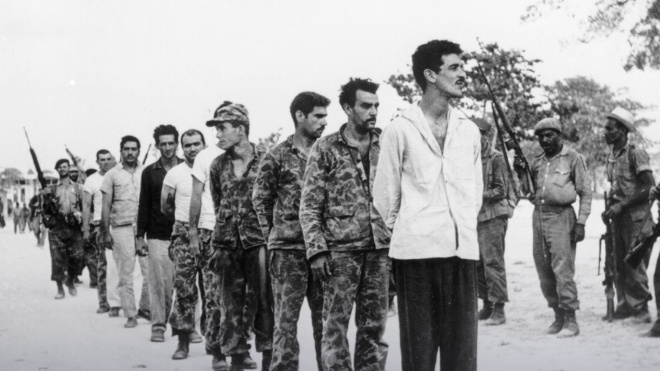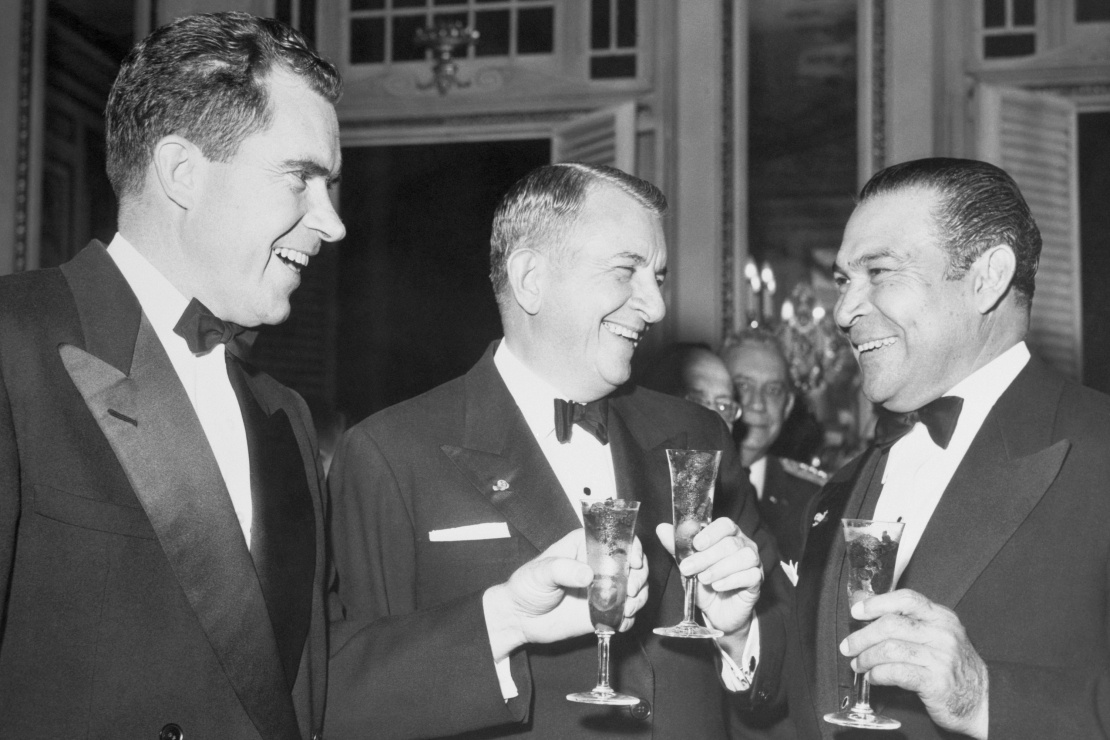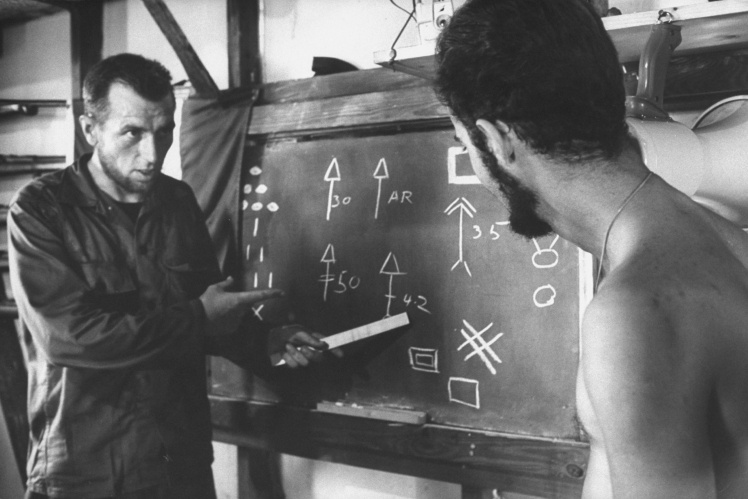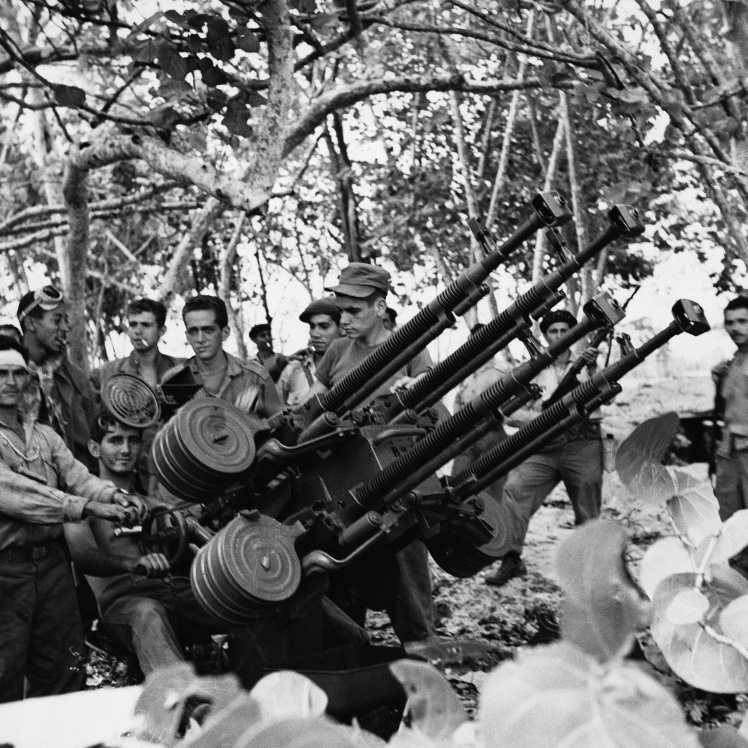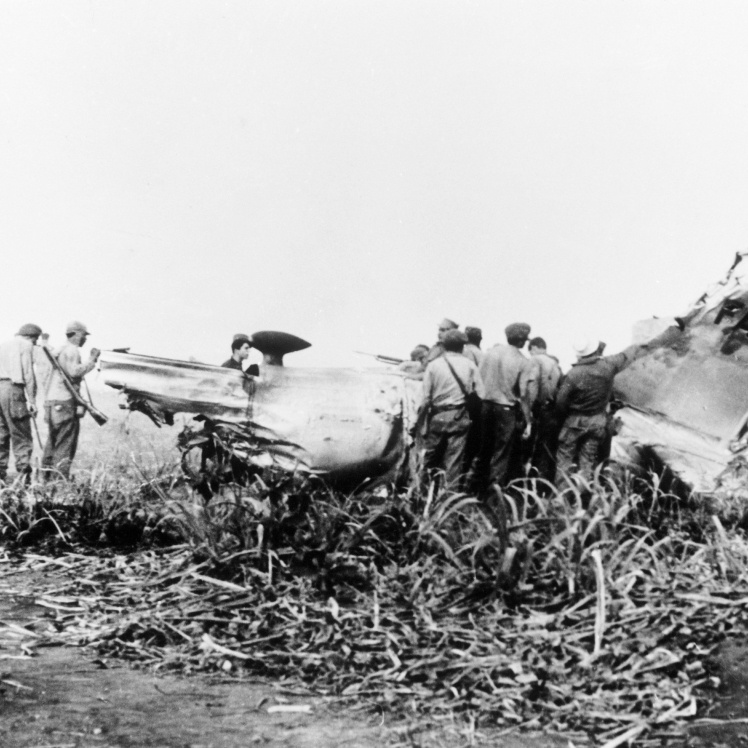In March 1952, General Fulgencio Batista staged a coup dʼétat in Cuba and seized power. He became a corrupt autocrat dictator, but was recognized by the United States. White House was pleased with Batistaʼs anti-communist position. But even more, he pleased American corporations, to whom he actually gave sugar cane plantations, mining and cattle breeding to buy.
Cuban dictator Fulgencio Batista (right) and US Vice President Richard Nixon (left) at a ceremonial banquet at the Presidential Palace in Cuba on February 8, 1955.
Getty Images / «Babel'»
Everything changed in January 1959. After several years of guerrilla warfare, Cuban rebels led by Fidel Castro overthrew the Batista regime. The US tried to establish relations with the new power and even recognized the Castro government. But very soon the relations between the countries deteriorated. Castro initially claimed that he wasnʼt a communist, but he acted with openly communist methods. Almost immediately after taking power, he nationalized the sugar, agricultural, and mining industries, removing American companies from controlling any land, property, or business in Cuba. Moreover, he called on the governments of other Latin American countries to follow his example.
Fidel Castro (center) gives a speech a few days after the overthrow of the Batista regime, January 4, 1959.
Getty Images / «Babel'»
The American government imposed an economic embargo on Cuba. And Castro began to establish relations with the Soviet Union. The then Soviet dictator Nikita Khrushchev was just waiting for an opportunity to "give a helping hand to the fraternal Cuban people" and get an ally in the Cold War right next to the USA.
At the beginning of 1960, the American Republican President Dwight Eisenhower decided that it was not worth delaying any longer and instructed the CIA leadership to develop a plan to overthrow the Castro regime. Because they had the experience of similar successful operations, for example, the coup dʼétat in Guatemala in 1954.
In March 1960, the CIA presented its plan to remove Castro from power. First, it was necessary to shake up the situation inside the country: conduct a propaganda campaign, unite and arm the Cuban opposition to wage a large-scale guerrilla struggle. Then they planned to land near the city of Trinidad, which is on the southern coast of Cuba. With the support of aviation, this landing was supposed to capture and hold a bridgehead on the coast. It was to be joined by partisans from the neighboring mountainous region of Escambray. Next, according to the plan, was to form a temporary opposition government that would be recognized by the United States and the pro-American governments of Latin America. If a large-scale insurrection against Castro did not begin even after that, this government could turn to the United States for military assistance.
Cuban émigrés fleeing the Castro regime at a customs checkpoint in Florida, January 1959.
Getty Images / «Babel'»
The main striking force of this landing was to be trained and armed Cuban migrants. So the operation could be presented as an internal conflict in Cuba. And those dissatisfied with the new government were enough. In the first six months alone, Castro surpassed his predecessor in terms of the scale of repression. Many insurgents, who until recently helped overthrow Batista, now opposed the new dictatorship. Thousands of people fled persecution to Florida, and in 1960 a true Cuban enclave was formed in Miami.
In April 1960, the CIA recruited the first 28 Cuban émigrés to participate in the upcoming landings. The first camp for their training was set up on the outskirts of Miami. Two thousand such volunteers were recruited already in half a year. Then, with the consent of local pro-American dictators, camps were set up for them in remote regions on the coast of Guatemala and Nicaragua. In the fall of 1960, they formed a group called "Brigade 2506" — after the personal number of the cadet who died during the training.
Cuban émigrés during training at a CIA camp, 1960. Theory classes for Cuban émigrés at a CIA training camp, March 1961.
Getty Images / «Babel'»
To prepare for the operation, President Eisenhower allocated $13 million, allowed the involvement of instructors from the US Ministry of Defense, but forbade the American military to take a direct part in hostilities. In the fall of 1960, Eisenhowerʼs second presidential term was coming to an end. So it was up to his successor, the Republican Richard Nixon, to bring the operation to order. But the elections were won by the candidate from the Democrats, John Kennedy with a minimal advantage of slightly more than 100 thousand votes.
After winning the election in November 1960, the CIA leadership broadly informed Kennedy about the operation. He generally approved the plan, only asked to concentrate more on supporting the internal partisan movement. The CIA promised that everything would be "quiet and successful", as in Guatemala. Kennedy initially did not ask for all the details, and in the months that followed he pretended that nothing was happening. He could and would want to cancel the operation if it were not for his pre-election promises. Kennedy built his campaign on sharp criticism of the Republicans, who "missed the communist threat 90 miles from the United States."
Pre-election debate between John F. Kennedy (left) and Richard Nixon (right), September 1960.
Getty Images / «Babel'»
While the new president hesitated, the CIA proceeded with the plan. Weapons, armored vehicles and a fleet of five cargo ships of the "Cuban Expeditionary Force" were prepared for the upcoming landing. In March 1961, the future provisional government, the Cuban Revolutionary Council, was created in Miami. It was headed by Jose Miro Cardona, one of Castroʼs closest allies, who became disillusioned with Fidelʼs policies and fled Cuba a few months after Fidel came to power. In case of success, it was Cardona who was to become the new president, who would be recognized by the United States.
Only at this stage did Kennedy begin to delve into the details of the operation. He said that in such a scenario, US involvement in the invasion would be too obvious. The operation has long been a secret not only for Cuban and Soviet intelligence, but also for American journalists. At the beginning of April 1961, they wrote that Cuban emigrants have been training in camps on the territory of the USA and Guatemala for almost a year. And the fact that the invasion was about to begin was actively gossiped on the streets and in Miami cafes — in a word, "everywhere where at least two Cubans gathered."
Cuban émigrés study a map at a CIA training camp, March 1961.
Getty Images / «Babel'»
However, Kennedy gave the CIA literally three days to rework the plan to ensure "maximum secrecy." The new plan consisted of two main phases. Initially, American bombers, painted as Cuban Air Force planes, would destroy aircraft at the Cuban military airfields. Then the landing party "Brigade 2506" was supposed to land. But not near Trinidad — about 160 kilometers to the west, in a deserted marshy area near the Bay of Pigs. But even the CIA leadership did not have a common opinion regarding further actions. Some believed that after the landing, a nationwide uprising would break out, which would reach Havana in a few days and overthrow the Castro regime. Others hoped that under the threat of total failure, the president would decide on open military intervention in Cuba.
Everything went wrong from the very beginning. On the morning of April 15, 1961, eight bombers with Cuban Air Force markings attacked three Cuban airfields. Then one of them landed at the Miami airport, its pilot said that he was a Cuban defector opposed to the Castro regime and asked for political asylum in the United States. However, the Cuban command managed to hide the planes, and several malfunctioning machines and models were left at the airfields. The staging with the "Cuban deserter" was exposed by American journalists in a few hours. After that, a frightened Kennedy banned further air support.
The aftermath of an airstrike at Santiago de Cuba airport on the islandʼs southeastern coast, April 15, 1961.
Getty Images / «Babel'»
At this time, the ships of the "Cuban Expeditionary Force" with approximately 1,500 troops were approaching the shores of Cuba under the cover of American destroyers. At midnight on April 17, the amphibious landing in the Bay of Pigs began. Another miscalculation was revealed here. What CIA aerial reconnaissance mistook for algae turned out to be sharp coral reefs. So part of the boats sank together with the paratroopers without reaching the shore. While the rest were trying to make their way through the reefs in the dark, they were spotted by a patrol of government troops and had time to radio the landing site.
Cuban government troops near one of the landing craft that managed to reach the coast of the Bay of Pigs, April 1961.
Getty Images / «Babel'»
In the morning, Cuban aviation appeared and bombed two ships carrying most of the weapons, ammunition and medicines. Others fled away from the shore. And at this time, the paratroopers, who were supposed to land in the depths of the island and block the only road leading to the landing site on the coast, got into the swamp and ultimately failed to cope with their task. There was no national uprising either. The Cuban police began mass arrests on the slightest suspicion of involvement in the opposition. In a few weeks, more than 20,000 people were behind bars. So, of all the planned diversions, only the arson of the central department store in Havana succeeded.
Cuban government troops near an anti-aircraft machine gun repelling the Bay of Pigs invasion, April 1961. One of the downed US aircraft with Cuban Air Force markings during the Bay of Pigs invasion, April 19, 1961.
Getty Images / «Babel'»
During April 19, four unmarked bombers, piloted by American volunteers from the Alabama Air Force, attempted to cover the invasion from the air. Two of them were shot down by Cuban air defense, the pilots were killed. In the evening of the same day, the main Cuban forces approached the landing site, which at least ten times outnumbered the landing force surrounded on the coast. Tanks and artillery pulled up. On the morning of April 20, almost 30 members of "Brigade 2506" managed to swim to the American ships standing in the bay. More than a hundred paratroopers were killed, and 1,202, including the wounded, were captured. Castroʼs army forces, according to official data, lost 176 people.
Captured Cuban emigrants attempting to land at the Bay of Pigs, April 20, 1961. Public trial in Havana of captured Cuban émigrés from Brigade 2506, April 10, 1962.
Getty Images / «Babel'»
For the USA, the operation turned out to be a complete failure — military and, most importantly, politically. Castro held public trials of captured members of Brigade 2506, where they confessed how they had been recruited by the CIA. Five were sentenced to death, about ten died of torture before the trial, and the rest received 30 years in prison for treason. At the end of 1962, most of the convicts were turned over to the United States in exchange for $53 million worth of food and medicine.
At that time, the Cold War reached its peak. In August 1961, the Berlin Wall appeared. And in the middle of the following year, Soviet dictator Khrushchev became so bold that he decided to "put a hedgehog in Uncle Samʼs pants" and place nuclear missiles in Cuba. This led to the Caribbean crisis in October 1962, which almost started World War III.
Fidel Castro (left) and Nikita Khrushchev (right) in the Kremlin during the signing of another Soviet-Cuban mutual aid pact, May 23, 1963.
Getty Images / «Babel'»
Translated from Ukrainian by Anton Semyzhenko.
We donʼt plan secret operations, but we tell about their successes and failures honestly. Support Babel: 🔸 in hryvnia, 🔸 Buy Me a Coffee, 🔸 Patreon, 🔸 PayPal: [email protected].
